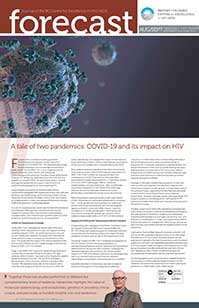
Founded with a mandate that includes persistent monitoring of viral diseases, the BC Centre for Excellence in HIV/AIDS (BC-CfE) has developed world-leading expertise in this increasingly crucial area of public health. As the SARS-CoV-2 virus swept around the planet in March of 2020, the BC-CfE’s Molecular Epidemiology and Evolutionary Genetics Group, led by Senior Scientist, Jeffrey Joy, expanded its focus from HIV and viral hepatitis to include COVID-19, exploring its global, national, and regional spread and the impact it had on both HIV treatment and populations at risk of acquiring HIV.
Briefly, using viral genome sequences and associated clinical characteristics integrated with evolutionary theory and methods, Dr. Joy and the Molecular Epidemiology and Evolutionary Genetics Group study how viruses evolve and adapt, monitor their transmission at multiple epidemic scales, and evaluate effectiveness of public health interventions in curbing their spread.
In a pair of complementary studies (performed with assistance of funding by CIHR, Genome Canada and Genome British Columbia) released in summer 2022, the group took aim at understanding Canadian SARS-CoV-2 transmission and the impact of COVID lockdown on HIV transmission in our at-risk populations.
COVID-19 Transmission in Canada
Firstly, using SARS-CoV-2 phylogenetic trees (family trees of the virus causing COVID-19 based on virus genome sequences) they carefully analyzed COVID-19 variant transmission into and across Canada and evaluated the impact that international travel restrictions had in curbing new introductions of the virus. This study was the subject of an article published in the journal eLife entitled: Genomic epidemiology of the first two waves of SARS-CoV-2 in Canada.
“Large-scale SARS-CoV-2 genomic epidemiology analyses in Canada have so far been limited to a study on the early epidemic within Quebec,” says lead author Angela McLaughlin, Research Assistant at the British Columbia Centre for Excellence in HIV/AIDS and PhD candidate in Bioinformatics at the University of British Columbia (UBC). “We wanted to elaborate on this research with a national-scale analysis for the first and second COVID-19 waves. Specifically, we evaluated the impact of international travel restrictions in March 2020 on international importations of the virus into Canada and on viral persistence into 2021.”
Their analysis tested the hypothesis that international travel restrictions enacted in March 2020 effectively reduced international importations of SARS-CoV-2 into Canada, yet ongoing introductions contributed to COVID-19 persistence into early 2021, exacerbated by highly transmissible B.1.1.7 and other VOC sublineages. They found that within 4 weeks from the implementation of travel restrictions, the rate of sublineage importation had dropped 10.3 fold. The restrictions drastically reduced, but did not eliminate transmission events attributable to international sources across all provinces.
Comparing the first and second waves of the pandemic in Canada, it was noted that in the first wave, early sublineages had the opportunity to become established and resulted in large transmission chains. However, the second wave lasting from August 2020 to February 2021 was driven by cases from newly seeded sublineages, suggesting travel restrictions were insufficient to prevent new outbreaks when domestic prevalence was low.
Restricting travel to and from locations with high relative COVID-19 prevalence, particularly attributable to emerging variants of concern, can be an effective tool to protect the healthcare system from being overwhelmed, but must be weighed against economic, social, and other impacts. Ongoing genomic surveillance in Canada and abroad to characterize changes in viral transmission and genetic variants are critical to inform evidence-based public policy on COVID-19 interventions.
Impacts of COVID on HIV Transmission in British Columbia
Collaborating with colleagues at the British Columbia Centre for Disease Control (BCCDC) and Vancouver Coastal Health (VCH), the BC-CfE’s Molecular Epidemiology and Evolutionary Genetics Group led a second high profile study focusing specifically on the impact that the lockdown period that occurred early in the pandemic had on HIV transmission in British Columbia.
The article titled: “Impact of SARS-CoV-2 lockdown on expansion of HIV transmission clusters among key populations: a retrospective phylogenetic analysis” carefully examined transmission patterns of HIV prior to, during, and after the lockdown. Looking at the interaction between the pandemics, this article revealed the impact of COVID-19 lockdown restrictions on individuals living with or at-risk of HIV infection and how the measures responding to one pandemic had consequences on another.
A potential positive side effect of the restrictions was that the drastic increase in amount of time spent at home likely led to a dramatic reduction in contact rates and a corresponding reduction in risk of HIV transmission in some populations at risk of acquiring HIV. Conversely, populations characterized by non-sexual transmission routes such as needle sharing may have experienced an increased risk of HIV transmission due to the limited access to health services such as harm reduction sites and clinics that were shut or offered reduced hours and/or capacity during the lockdown.
Investigating the hypothesis that differential trends in rates of transmission of HIV resulted from the implementation of lockdowns because of the reduced access to HIV management and prevention services, the article noted that a reduction in new infections diagnosed during the COVID-19 pandemic may relate to a decrease in willingness to seek sexual health services.
The findings of the study indicate that populations of men who have sex with men (MSM) experienced a decline in detected HIV transmission based on cluster growth, to a level rarely seen in the previous 3 years, supporting the idea that reduced social contacts and increased time at home favourably reduced transmission. However, amongst people who inject drugs, the analysis revealed a contrasting pattern with a peak of HIV transmission higher than observed in the same time periods in the previous 3 years.
Notably, clusters associated with populations of people who inject drugs (PWID) continued to experience elevated growth well beyond the initial period of instability in health service availability, indicating that the effects of such gaps can be long-term and difficult to counterbalance. The long-term downstream effects of these disruptions to engagement with HIV care services are yet to be seen, but studies estimate the negative impacts to be substantial.
Lead author, Rachel Miller, Research Assistant at the BC-CfE and recent MSc graduate in Bioinformatics from UBC noted, “The difference in transmission revealed between at-risk populations highlights the need for persistence and increased vigilance in caring for our vulnerable populations during crises or times of public health emergency. Providing services to this group should be more like the treatment and care of those with diabetes or other chronic conditions because the consequences of interruption can be long-term and severe.”
Increasing vigilance and using innovative, targeted solutions are necessary to offset potential negative impacts on HIV treatment and prevention stemming from current and future pandemics or other major public health events.
Taken together these two studies performed at different but complementary levels of epidemic hierarchies highlight the value of molecular epidemiology and evolutionary genetics in providing critical, unique, and practically actionable insights into viral epidemics. They further highlight the importance of timely sharing of genomic data in allowing these inferences to be made and that organizational collaboration strongly facilitates direct, effective responses to public health crises.
– Dr. Joy, Senior author on both studies

